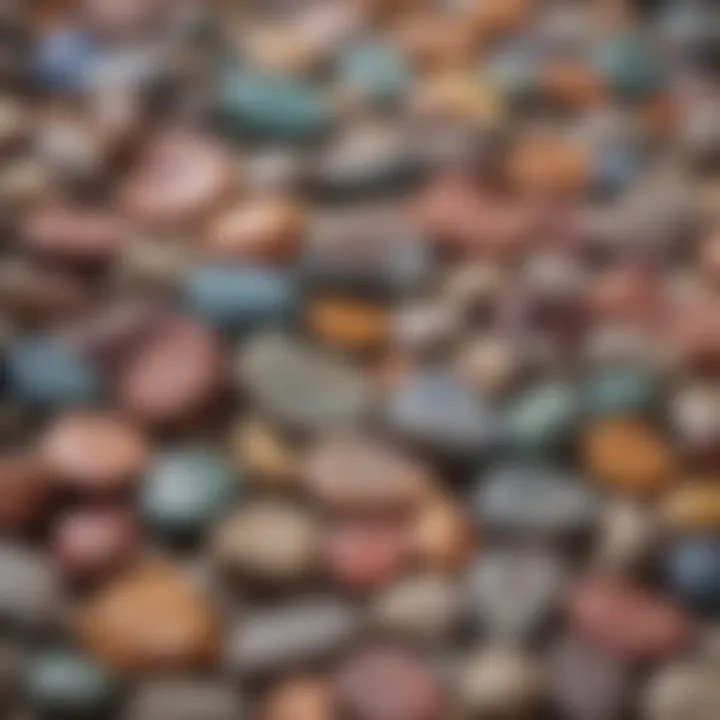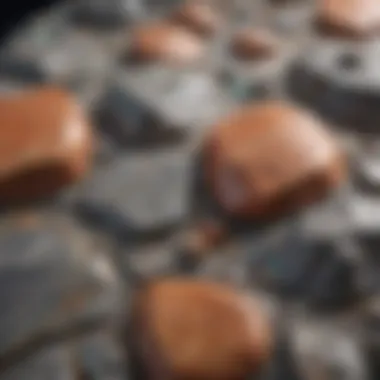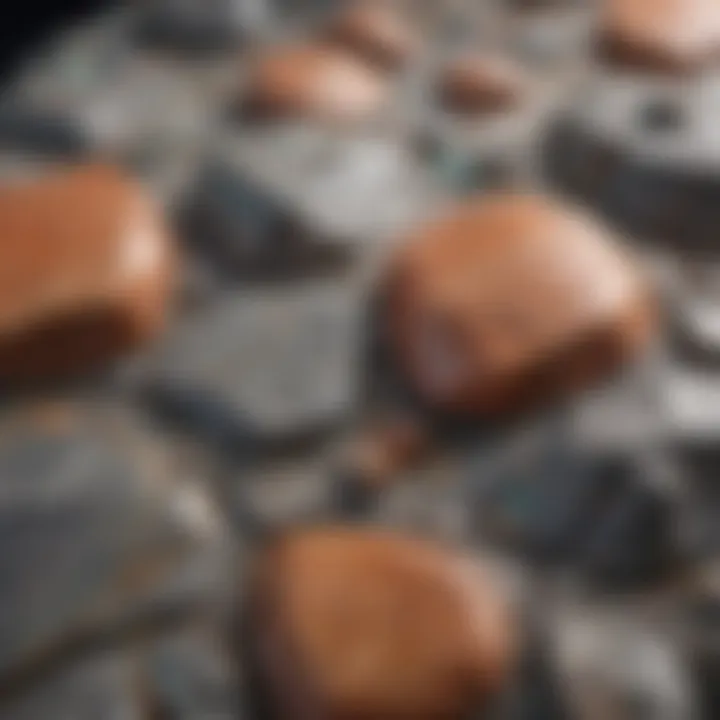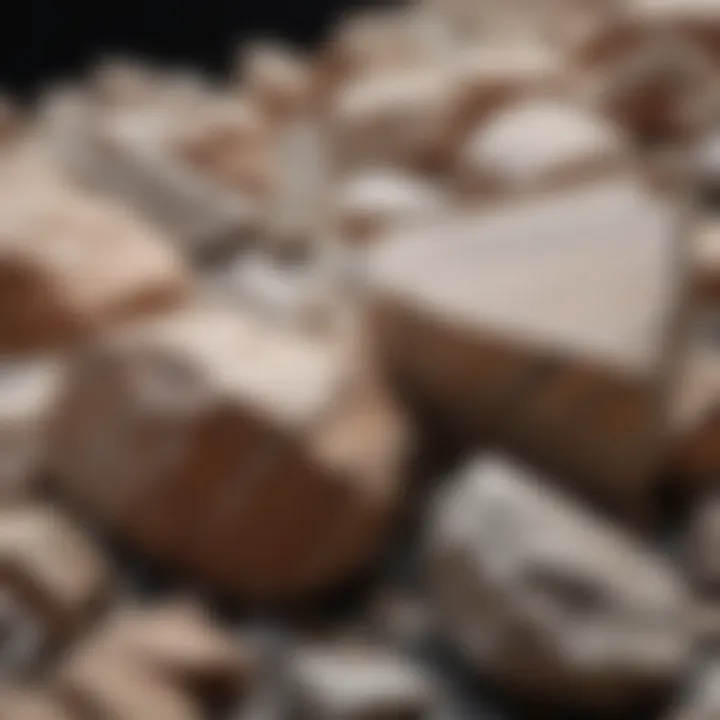Exploring the Spectrum of Quartzite Colours


Intro
When you think of quartzite, the mind often conjures images of solid, unyielding stone. But beneath this tough exterior lies a world of colors waiting to be explored. Each hue tells a story, shaped over eons by geological processes and environmental influences. From the soft whites and grays to vibrant reds and blues, the spectrum of quartzite colors fascinates both the novice and the seasoned collector alike. Understanding these colors isn't just about aesthetics; it's a gateway to appreciating the rock's history, its formation, and its potential uses.
Mineral composition plays a crucial role in defining quartzite’s colors. The minerals that form alongside quartz, whether they be iron oxides or organic matter, contribute unique tones that can transform the appearance of this metamorphic material. Explore these characteristics to unlock the potential value and beauty that each piece can hold.
In the sections that follow, we will embark on a journey to uncover the myriad colors of quartzite, the geological tales they tell, and practical implications for collectors and enthusiasts. Whether you stumble upon some striking quartzite pieces at a local show or in a geological setting, knowing how to identify and appreciate them enhances the joy of discovery.
Featured Collectible of the Month
Overview
This month, we shine a spotlight on the exquisite Milan Pink Quartzite. Known for its blend of gentle pink and cream tones, this collectible captures the eye and heart of many. Originating from the majestic quarries in Italy, its unique color derives largely from the iron content within the stone, giving it a warm glow that is hard to resist.
Historical Significance
Milan Pink Quartzite isn’t just a pretty face; it carries a history steeped in artistry. Used since ancient Roman times, this stone has adorned numerous architectural masterpieces, including palaces and temples. Its durability and beauty have made it a favorite of architects and sculptors alike throughout history. Today, collectors cherish it not only for its visual appeal but also for the rich narrative it embodies.
Identification Techniques
Identifying quartzite colors can sometimes feel like searching for a needle in a haystack. But with the right techniques, it becomes more of a treasure hunt.
Visual Characteristics
To distinguish between varieties, pay attention to:
- Color Variations: Observe the base color, but also look for streaks or patterns that hint at the mineral composition.
- Texture: Quartzite typically has a granular feel, different from smooth marble or sharper granite.
- Clarity: Some quartzites exhibit transparency, especially if they contain lesser amounts of impurities.
Resources for Identification
Hungry for more information? Consider checking these resources:
- Wikipedia
- Britannica
- Reddit – Engage with fellow enthusiasts in the community
- Facebook groups focused on mineral collecting can also be treasure troves of info.
In closing, recognizing the shades and stories behind quartzite cultivates a deeper appreciation for this metamorphic marvel. The world of quartzite colors is vast, and as you dive deeper, you’ll uncover secrets that make each piece unique.
Prolusion to Quartzite
Quartzite, a fascinating metamorphic rock, holds a special place in both the geological context and the realm of materials used in construction and design. This section is critical to understanding the diverse world of quartzite colours, which arise from the interplay of geological processes, environmental influences, and mineral composition. For rock and fossil collectors, appreciating quartzite goes beyond mere aesthetics; it’s about grasping the history etched into the stones they covet.
Defining Quartzite
To understand quartzite, one must first recognize what distinguishes it from other types of stones. Quartzite is primarily composed of quartz grain, which is formed when sandstone undergoes high heat and pressure. This process transforms the sand into a dense, hard rock. The grains interlock tightly, creating a structure that is not only visually appealing but also incredibly durable.
Quartzite is often mistaken for granite, but the main difference lies in its formation—where granite originates from cooled magma, quartzite evolves from pre-existing sandstone. This transformation can lead to a stunning array of colours, ranging from soft whites to vivid reds and deep blacks, depending on the impurities present and the conditions of formation. By grasping this definition, collectors can better appreciate the nuanced beauty of quartzite and its varied manifestations.
Composition and Formation
Diving deeper into the composition and formation of quartzite opens up a realm of intricate details. At its core, quartzite is composed almost entirely of quartz, making it markedly hard and resistant to weathering. The natural world is not shy with its creativity; impurities such as iron oxide, manganese, and other minerals can color quartzite, leading to striking variations. For instance, iron can impart a golden hue, while manganese may lend a pink or purple tint.
Formation happens in two stages: the first entails the accumulation of sediments to form sandstone, and the second involves the metamorphosis of that sandstone under heat and pressure. Over time, as geological shifts occur, layers of sandstone may become buried, experiencing increased temperature and pressure, thus crystallizing the quartz within. This transformation is often what makes quartzite such an intriguing study area—not just color, but the entire history locked within the stone itself.
"The beauty of quartzite lies not just in its colour, but in the story it tells about the Earth's dynamic processes."
In summary, understanding quartzite requires an exploration of its definition, composition, and the formation process that breathes life into its diverse colours. For those venturing into the realm of quartzite collection, this knowledge serves as the foundation for informed appreciation and selection.
Understanding Colour Variations


Understanding the variations in colour that quartzite exhibits is crucial, not just for those who are collecting these remarkable stones, but also for anyone interested in geology and mineral science. The colour of quartzite is not merely an aesthetic quality; it encapsulates a history of geological processes, the mineral composition, and environmental conditions under which the rock formed. When we explore the colours of quartzite, we tap into a narrative that spans millions of years, revealing insights that deepen our appreciation for this metamorphic rock.
Some key points to consider when discussing colour variations include:
- Mineral Composition: Different minerals impart unique colours. For instance, iron can turn quartzite shades of red or yellow, while manganese can lend a greenish hue. Each mineral's characteristics dictate the visual appearance of the stone.
- Environmental Conditions: Temperature, pressure, and the chemical environment during formation can affect how and which minerals crystallize, ultimately influencing colour.
- Identification Aid: Understanding the colour variations allows enthusiasts and collectors to identify quartzite specimens accurately, enhancing the collecting experience.
By grasping these principles, one is not just observing a solid mass of rock but rather a complex interplay of geological history and mineralogy.
Fundamental Colour Principles
Colour in quartzite arises from various factors. Primarily, it comes down to the presence of different impurities and minerals during the formation of the rock. Each colour is deeply tied to specific elements. For example, white quartzite is primarily composed of quartz, while grey quartzite suggests the presence of silica and other minerals. In contrast, more vivid colours tend to signify a larger range of impurities.
Here’s a breakdown of foundational colour principles:
- Hue: This refers to the basic colour, such as red, blue, or green. It defines the shade of the quartzite.
- Saturation: This aspect determines the intensity of the colour. Saturated colours are bright and vivid, while less saturated colours appear more muted.
- Value: Value indicates how light or dark a colour is. High-value colours are closer to white, and low-value colours are closer to black.
In quartzite, the way these principles interplay affects how collectors perceive and appreciate the stone. For example, a deep red quartzite might be more sought after than a light brown variant not just for its beauty, but also for its rarity and mineral content.
Cultural Perception of Colour
Cultural perspectives significantly influence how we think about and value colours—this holds true in the realm of quartzite as well. Different societies have ascribed varying meanings to specific colours throughout history. This can affect not only the demand for quartzite in artistic and construction contexts but also the emotional connections people have with particular stones.
Here are some insights into cultural nuances of colour perception:
- Symbolism: For example, many cultures see green as a symbol of growth and renewal. Hence, green quartzite may be more prized within communities valuing these traits.
- Functional Preferences: Some colours may also be more desirable due to functional aspects. For instance, lighter colours may be preferred for indoor spaces to create a sense of openness, affecting buyer trends.
- Traditions and Beliefs: Certain colours might hold spiritual significance. In many Native American cultures, for example, certain hues can be tied to traditional ceremonies or healing practices, enhancing their desirability as collectibles.
Ultimately, colour variations in quartzite reflect a smaller world view—a mirror to human culture itself, adding layers of meaning to what might seem like just a beautiful stone.
Key Colours of Quartzite
In this section, we turn our spotlight on the key colours of quartzite. Understanding these colours is not just about the aesthetic appeal; it also plays a crucial role in identifying the stone's origins, properties, and potential uses. Each colour tells a story, reflecting the minerals and conditions present during formation. By delving into these hues, rock and fossil collectors can make informed decisions, whether they are sourcing materials for a project or adding to their collections.
White Quartzite
White quartzite is often seen as the standard bearer of this metamorphic rock. Its brilliance sparks interest right away, making it a popular choice in construction and design. The purest form is almost entirely composed of quartz, giving it an unmatched translucence and durability.
This colour typically results from the high purity of quartz sand grains that underwent substantial metamorphism. The stone often presents variations, with some pieces displaying faint inclusions or feathery patterns that hint at its geological history. Interestingly, white quartzite serves as a versatile backdrop in various settings, from bathroom countertops to elaborate sculptures, showcasing its adaptability and timeless appeal.
Gray Quartzite
Gray quartzite marks the intersection between understated elegance and rugged durability. Often created from granite, this colour embodies a more muted palette while retaining a striking presence. The grey hues may vary from soft silver to deeper charcoal shades, often reflecting the minerals present in the rock's matrix.
In many cases, grey quartzite also exhibits unique veining and patterns that can provide added character to spaces. Decorators and homeowners often lean toward this colour for its ability to blend seamlessly with other tones—be it in flooring, walls, or decor pieces. For collectors, the subtleties in pattern and shade can enhance the stone's value.
Rose Quartzite
The gentle blush of rose quartzite is indicative of high levels of iron or manganese in the composition. This appealing colour can range from soft pastel pink to bold magenta, making it a sought-after choice for decorative elements. This type of quartzite not only possesses beauty but also hints at the geological processes that shaped it.
Rose quartzite carries both aesthetic and metaphysical attributes—often sought after for its association with love and harmony. In terms of applications, it finds homes in jewelry, art pieces, and various decorative items, blending functionality and beauty.
Green Quartzite
Green quartzite brings the vibrancy of nature indoors. It usually gains its colour from iron oxides and chlorite, and like a painter's brush on a canvas, its tones can extend from soft sage to deep forest green. Unique patterns often emerge, creating organic shapes reminiscent of foliage.
This colour is particularly prized in landscaping stones and outdoor structures, as it evokes a sense of tranquility. For collectors, green quartzite can signify environmental changes over millennia, and each specimen could provide insights into its formation and regional characteristics.
Red Quartzite
Red quartzite stands out with its bold intensity, a product of iron oxides that enrich its surface with warm hues. Its striking visual appeal often draws enthusiasts and designers alike. Many feel a strong connection to this stone, associating it with strength and vitality.
The intricate display of red strands amid lighter tones adds depth to a piece, making it suitable for statement installations, sculptures, or intricate jewelry. From an ecological perspective, red quartzite may also provide clues about the Earth's atmosphere during its formation, adding layers to its already rich narrative.
Black Quartzite
Black quartzite exudes an aura of elegance and mystery. The darkness typically arises from high concentrations of various minerals, including carbon, which can lead to a deep, glossy surface. Collectors often value it for its rarity and the dramatic contrast it can provide in design work.
This colour is frequently utilized in contemporary architecture, lending a sleek finish to interiors and exteriors alike. Beyond aesthetics, black quartzite tends to embody resilience, making it a practical choice for a variety of applications—from flooring to kitchen islands. Each slab tells a story, steeped in geological history and artistic potential.
"Colour can enhance or diminish the allure of quartzite—understanding its nuances becomes essential for both appreciation and application."


Understanding the myriad colours of quartzite can enhance your appreciation for this remarkable stone. Each hue carries with it information about not just the appearance but also the processes that shaped it—all enriching a collector's journey into the deeper qualities of quartzite.
The Role of Impurities
When delving into the fascinating world of quartzite, one cannot overlook the significant contributions that impurities make to its color and overall aesthetic. Impurities in quartzite arise from various minerals present during the metamorphic process, and they play a pivotal role in determining the rock's final appearance. Understanding these impurities and their influences helps not only in identifying the stone but also enhances appreciation for its beauty and uniqueness.
Iron and Its Effects on Colour
Iron is a heavy hitter when it comes to imparting color to quartzite. When iron oxides mingle with the silica that primarily composes quartzite, the results can yield vibrant reds, browns, and even yellows. This is due to the oxidation state of iron—ferric iron (Fe³⁺) tends to produce warm hues like red and yellow, while ferrous iron (Fe²⁺) might lean towards greens and darker shades. Even slight variations in iron content can lead to dramatic shifts in color.
The presence of iron not only affects the quartzite's coloration but also its durability. High iron content can contribute to weathering, which could gradually diminish the stone’s vibrancy over time. Therefore, collectors and enthusiasts should consider potential iron-related issues when sourcing quartzite pieces for their collections.
Geological Influences on Quartzite Colour
Understanding the geological influences on quartzite color is paramount for anyone who desires to truly grasp the inherent complexity of this rock. The alteration of colors in quartzite isn't just about aesthetics—it's a story of the Earth’s history, chemical reactions, and environmental conditions that together shape its vibrant hues.
Formation Conditions
The formation of quartzite begins under significant heat and pressure, typically from sandstone. However, this metamorphic process is far from uniform. Conditions like temperature, pressure, and the presence of fluids play crucial roles in determining the final coloration of quartzite. For instance, higher temperatures generally lead to the development of darker tones due to mineral reactions that may incorporate more iron, giving rise to shades of red and brown.
Conversely, cooler conditions might allow the quartzite to retain lighter shades. Additionally, the availability of certain minerals during formation significantly impacts the color. The presence of titanium or manganese can add a striking depth to the stone, while a lack of these minerals can lead to more muted shades. It's fascinating to think how such conditions could result in a spectrum ranging from vibrant reds to soft pastels, showcasing the dynamic nature of the Earth’s processes.
Regional Variances
When looking at quartzite, it’s essential to consider regional variances which factor into their colors. Different geographic locations provide unique environmental contexts that influence the minerals present during the rock's formation. For example, quartzite found in the southwestern United States often appears in sandy hues, influenced by the sedimentary layers in that region.
On the other hand, quartzites from areas with volcanic activity may exhibit striking greens or blacks, attributed to the interaction with volcanic ash and minerals. In places like Brazil, where rich geological diversity occurs, collectors may find quartzite showcasing brilliant pinks or yellows thanks to varied local conditions and mineral interactions over time.
In summary, gaining knowledge about the geological influences on quartzite colors offers collectors valuable insights into not just the appearance but also the authenticity and story behind each specimen.
"The color of quartzite is not just about what meets the eye; it is a reflection of the geological tale written in stone."
By understanding how formation conditions and regional variances contribute to these colors, enthusiasts can appreciate the deeper significance each piece holds. Each time you admire a slab of quartzite, remember, it’s more than just a pretty rock; it’s a testament to geological history embodied in myriad colors.
Practical Applications of Quartzite Colours
Understanding quartzite’s colours isn’t just a scholastic endeavor; it manifests practical significance across a variety of fields. From construction to aesthetics, knowing how to leverage these hues can influence decisions that affect both functionality and visual appeal. This section will delve into the multidimensional applications of quartzite colours and how they inform choices in material selection and design.
Usage in Construction
In construction, the choice of materials extends beyond structural integrity and encompasses aesthetic choices as well. Quartzite, with its vibrant hues, serves not just as a durable building stone but also as a statement piece. The first thing to recognize is the adaptability of quartzite in architectural design. For example, a white quartzite can lend an air of elegance and brightness to exterior façades, whereas black quartzite can portray strength and sophistication, often seen in modern urban architecture.
- Durability is one of the key benefits: Quartzite is known for its strength and resilience against weathering, making it an excellent choice for both interior and exterior uses.
- Versatile design options: Different colours can be utilized to create distinctive aesthetics. Imagine a green quartzite incorporated into a garden pathway, complementing the vibrant greens of foliage.
- Reflecting natural elements: By selecting specific colours, architects and designers can harmonize with the surrounding terrain. Rose quartzite, resembling delicate flowers, can beautifully reflect gardens or natural landscapes.
The impact of colour in construction is not merely a matter of appearance. It can influence thermal properties and energy efficiency, too. For instance, lighter hues can help in reducing heat absorption, which is crucial in hot climates.
Aesthetic Considerations in Design
When it comes to design, the colour palette of materials speaks to more than just visual appeal; it communicates emotion and sets a tone for spaces. Quartzite offers an extensive palette, from rich earthy tones to striking colours, which allows for creative freedom. Here are some aspects to ponder when considering quartzite colours in design:
- Mood Setting: The colour can evoke different feelings depending on its application. A calming light gray quartzite in a spa creates a serene atmosphere, while bold red quartzite in a lounge might spark energy and conversation.
- Enhancing Textures: The natural textures of quartzite can complement its colours. Pairing a smooth, glossy black quartzite with matte finishes can create a rich visual dialogue, adding depth to the overall design.
- Cultural Resonance: Different cultures may imbue distinct meanings to certain colours. Incorporating locally significant hues can connect a space to its geographical heritage, making it more than just a room—it becomes part of a story.
"Understanding the emotions tied to colours can transform a space and enhance how people experience it."
Finally, while weaving quartzite colours into your projects, it’s important to consider balance. Too many contrasting colours may overwhelm the senses, while too few may lack engagement. Find the right balance is essential in achieving harmony.
Identifying Quartzite by Colour


Identifying quartzite by its colour is crucial for anyone involved in the mining industry, rock collection, or even just home decoration. Quartzite comes in a spectrum of colours, each influenced by minerals and impurities within the rock itself. This identification not only assists enthusiasts in determining the value and potential application of their specimens but also helps in distinguishing quartzite from similar stones, such as granite or sandstone.
By understanding the visual cues and tools available, collectors can enhance their appreciation of this metamorphic rock. Here, we delve into techniques for accurately identifying quartzite colours alongside the tools you’ll need for effective assessment.
Visual Identification Techniques
Visual identification of quartzite involves a keen eye for its distinct colour characteristics. One must look for:
- Colour Depth: The intensity of a quartzite’s colour can vary significantly. For instance, you might notice that grey quartzite is often linked to different levels of iron content, impacting how vivid or muted the hue appears.
- Patterns and Textures: Commonly, quartzites show banding or flecking, which can tell you much about their mineral makeup. A rose quartzite, for instance, might have faint blush stripes that give it a unique, delicate appearance.
- Light Reflection: The way light interacts with the stone is also a telling characteristic. High-quality quartzite often has a shiny luster due to its crystalline structure. Hold the specimen under various lighting conditions to assess the reflections properly.
"The beauty of quartzite isn’t merely in its hue—it's in how it reflects the world around it."
- Scratch Test: Although a bit crude, gently scratching the surface can help. Quartzite is harder than many other rocks, so a scratch won't easily affect it. If you notice a mark, it may not be quartzite.
Tools for Accurate Assessment
Having the right tools can make a big difference in identifying quartzite effectively:
- Hand Lens: A simple hand lens can help you better see the mineral composition. Tiny crystals might reveal much more about the stone’s identity than you can see with the naked eye.
- Polariscope: For those seeking even deeper understanding, a polariscope can unveil whether the quartzite is isotropic or anisotropic. This is a handy technique for those who take their collection seriously.
- Refractometer: Measuring the refractive index with this tool can yield precise data on the quartzite’s mineral content, helping to confirm its identity.
- v-Analyzer: This innovative tool can provide a visual spectrum analysis, which outlines how a quartzite specimen behaves under different wavelengths of light.
Understanding and utilizing these techniques and tools enables collectors, whether novices or experts, to recognize and appreciate the variances within quartzite. As you delve into the world of this multifaceted rock, remember that each specimen presents a unique story portrayed through its colour.
Caring for Quartzite Collectibles
Caring for quartzite collectibles is crucial for any enthusiast or collector who appreciates the beauty and intricate details of this metamorphic rock. Unlike some other stones, quartzite can vary significantly in durability based on its mineral composition and the conditions under which it was formed. Therefore, understanding how to maintain its allure is key. Adequate care not only enhances the aesthetic appeal of these pieces but also prolongs their life, making them an essential part of any collection.
Throughout this section, we’ll highlight practical cleaning methods, long-term preservation strategies, and considerations that collectors should keep in mind. The goal is to ensure your quartzite pieces are well cared for, allowing them to shine beautifully for years to come.
Cleaning Techniques
When it comes to cleaning quartzite collectibles, the best approach is often gentle yet effective. It's vital to avoid harsh chemicals that could damage the rock's delicate surface. Here are some tips for keeping quartzite clean:
- Use a Soft Cloth: A microfiber cloth is ideal for dusting off any particles that accumulate on the surface.
- Mild Soap Solution: Mix warm water with a small amount of mild soap, such as dish detergent. Dampen a cloth with this solution and gently clean the quartzite. Be sure not to soak the rock as excess moisture can seep into small crevices.
- Avoid Scrubbers: Never use abrasive materials, as they can scratch the surface. If there are tougher stains, consider using a soft brush instead.
- Dry Thoroughly: After cleaning, allow the quartzite to air dry completely. It’s crucial not to leave any moisture behind, as water can lead to further issues like staining or crystallization.
Long-term Preservation Tips
If you wish to keep your quartzite collectibles looking their best over the long haul, consider the following preservation tips:
- Store Properly: Keeping quartzite in a controlled environment is essential. Avoid areas that experience extreme temperature fluctuations, humidity, or direct sunlight.
- Use Display Cases: Displaying quartzite collectibles in glass cases can help protect them from dust and physical damage while allowing their beauty to be fully appreciated.
- Regular Check-ups: Make it a habit to inspect your collection periodically for any signs of wear or damage. Early detection can help you address small issues before they become significant problems.
- Consider Protective Coatings: For some pieces, applying a non-toxic sealer may provide an additional layer of protection against stains and scratches, though this should be done judiciously.
Maintaining the beauty of quartzite collectibles goes beyond mere cleaning; it involves a holistic approach that considers their storage environment and how frequently they are handled.
Ensuring that quartzite collectibles receive proper care is an integral part of any collector's responsibility. By following these cleaning techniques and long-term preservation tips, you can create a stunning collection that remains in excellent condition, allowing future generations to enjoy the brilliance of quartzite.
Ending: The Significance of Colour in Quartzite
Understanding the significance of colour in quartzite is not just a matter of aesthetic appreciation; it's an essential key to unlocking the geological history embedded in each slab of rock. Quartzite is formed from sandstone under intense heat and pressure, which can drastically alter its colour palette. A stone’s hue can tell collectors not only about its mineral makeup but also about the environmental conditions prevalent at the time of its formation. These considerations are paramount for enthusiasts and professionals alike.
Recapping Key Insights
As we step back and review the journey through quartzite colours, several key insights surface:
- Diverse Palette: Colours range from pure white to deep blacks, each revealing different weathering processes and mineral content.
- Geological Story: Understanding the origin of each colour can provide powerful context. For instance, hues influenced by iron oxides echo the ancient conditions of the Earth’s crust.
- Cultural Connections: Colours often hold different meanings across various cultures, impacting their desirability in marketplaces and design. Certain colours might fetch a higher price due to their rarity or perceived beauty.
- Functional Applications: While colours attract collectors, practical considerations in construction also hinge on these variations. A deeper understanding can aid in decision-making for residential or commercial projects where both aesthetics and performance matter.
This summarization forms a foundational view of quartzite that not only enriches the knowledge of current collectors but also sets the stage for future learning.
Future Exploration and Study
The future holds a treasure trove of opportunities for further exploration. As technology advances, techniques such as imaging spectroscopy allow for a more nuanced examination of quartzite's unique colour characteristics. This could lead to breakthroughs in understanding how minute chemical variations affect colour intensity and distribution.
Additionally, the ongoing study of climate changes and their effects on mineral deposits can reshape our understanding of quartzite formation across different regions. As collectors and geologists alike delve deeper into these subjects, collaboration is vital. Engagement with online forums, such as reddit.com, and academic resources will foster a richer dialogue among varying levels of expertise.
"The more we study the nuances of quartzite colours, the more we appreciate the intricacies of the Earth itself."



